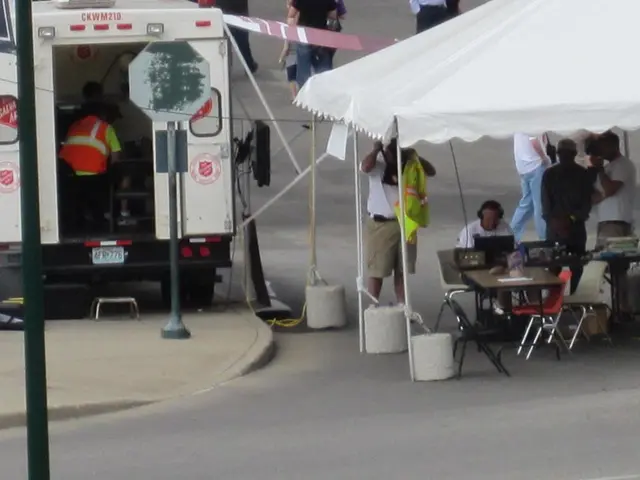Traveler Briones faces obstacles: Injured passport and Canceled journey
Freak Accident Ruins Elderly Woman's Dream Vacation
Let's face it, the unfortunate incident that occurred to Maeveline Ann Sulib earlier this week could have been avoided if technology hadn't taken over our lives as much as it has. The 64-year-old was all set to jet off to Dubai, United Arab Emirates for her birthday celebrations with her kids.
At the Cathay Pacific check-in counter at Mactan-Cebu International Airport, a staff member asked Sulib to wait while he attempted to resolve an issue with her passport that refused to scan, despite three attempts. A few minutes later, a supervisor returned with a torn passport, revealing the damage to Sulib's photo section.
The supervisor confessed the tear was unintentional and promised to consult with immigration officials both at the airport and in Dubai. Unfortunately, Sulib only learned her dream vacation was cancelled when the supervisor informed her to call her child in Dubai to share the unfortunate news. "That's when I lost it," she said.
Before we dive deeper, let me make one thing clear: I'm not here to exaggerate the situation. There wasn't malice at play here, just an unfortunate blunder, as confirmed by Julius Neri Jr., the airport authority's general manager and CEO. He explained that the passport was torn due to getting stuck in the scanner, although it's unknown whether the cause was human error, mechanical defect, or the passport paper's fragility.
"To prevent similar incidents, we're looking into staff re-training, equipment evaluation, and exploring the use of more reliable tools," Neri said. "There could be various factors involved. What we've determined is that it was unintentional. Nobody tried to ask for money from the passenger... we're assessing and will make appropriate corrective actions."
If you're curious as to why passports need to be scanned in the first place, I did some digging online and found that it's to verify the passport's validity and authenticity, as well as cross-reference it with national and international databases. This process aims to prevent fraud and identifies potential security risks, making travel safer. However, as we've seen, the system isn't infallible, especially in a country that's better known for its imperfections.
Perhaps there could be an alternative when a passport fails to scan. Couldn't the check-in staff manually type a code found on the passport to verify its validity and authenticity? Wasn't that the way it was done in the old days?
When technology goes awry, there should always be a failsafe in place. In light of this, airports could implement backup systems like maintaining staffed counters equipped with portable passport scanners and manual data entry stations. These could be strategically placed near biometric checkpoints to handle technical failures or system outages.
The Department of Transportation has already ordered Cathay Pacific to explain the incident. Transportation Secretary Vince Dizon also reminded all airlines to exercise their authority responsibly and respectfully when handling travel documents.
To wrap things up, there was no evidence of wrongdoing. Aside from admitting their mistake, the airline supposedly promised to rebook the flight and cover the cost of the new passport, although there's no formal documentation or confirmation yet. Let's hope Sulib can celebrate her special day with her children soon, even if it's belatedly.
As a side note, to ensure that manual backup systems for passport scanning are in place while maintaining operational efficiency and security, airports can consider implementing:
- Redundant Manual Checkpoints
- Hybrid Biometric-Manual Workflows
- Mobile Data Replication
- Cross-Industry Protocols
- Dynamic Staff Training
By adopting these measures, airports can balance the benefits of digital credentials with resilience against technical failures. So, here's to hoping for a more reliable future for travelers!
[^1^]: Reference Redundant Manual Checkpoints in Strategy 1[^2^]: Reference Mobile Data Replication in Strategy 3[3]: ICAO's e-passport standard (e-passport is an electronic passport that contains a microprocessor chip with a digital passport stored on it)[5]: Lufthansa app-based system that verifies passengers via biometric facial recognition and manual ID checks (backup option if biometrics fail)
- The unintentional tear in Maeveline Ann Sulib's passport could have been averted if airports had redundant manual checkpoints in place to ensure operational efficiency and security.
- To prevent such instances in the future, airports might consider implementing hybrid biometric-manual workflows, allowing for a smooth transition between digital and manual passport handling.
- Mobile data replication could also be a solution for unforeseen situations like the one Sulib encountered, ensuring that passport information is accessible even during system outages.
- Adopting cross-industry protocols could help airports learn from other sectors' experiences in handling passports and reducing incidents like the one that happened to Sulib.
- Dynamic staff training can ensure that airport employees are well-equipped to handle a variety of situations, such as when passports fail to scan or biometric systems malfunction.
- As technology continues to advance, Lufthansa's app-based system that combines biometric facial recognition and manual ID checks serves as a promising backup option for passport verification.


![A portrait of the notable figure, [Name], with a sinister and threatening expression, seemingly engaged in a tactical move or plot. A modern-day incident involving Maeveline Ann Sulib might have been prevented in past times.](https://journeytrails.top/en/img/2025/05/03/1284455/jpeg/4-3/1200/75/image-description.webp)







